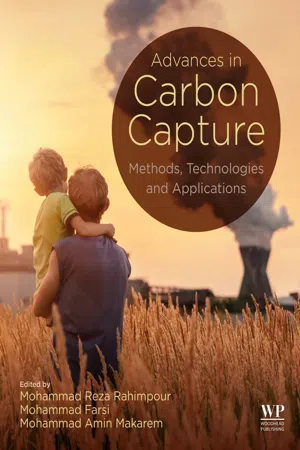
Advances in Carbon Capture
Methods, Technologies and Applications
- 572 pages
- English
- ePUB (mobile friendly)
- Available on iOS & Android
Advances in Carbon Capture
Methods, Technologies and Applications
About this book
Advances in Carbon Capture reviews major implementations of CO2 capture, including absorption, adsorption, permeation and biological techniques. For each approach, key benefits and drawbacks of separation methods and technologies, perspectives on CO2 reuse and conversion, and pathways for future CO2 capture research are explored in depth. The work presents a comprehensive comparison of capture technologies. In addition, the alternatives for CO2 separation from various feeds are investigated based on process economics, flexibility, industrial aspects, purification level and environmental viewpoints.- Explores key CO2 separation and compare technologies in terms of provable advantages and limitations- Analyzes all critical CO2 capture methods in tandem with related technologies- Introduces a panorama of various applications of CO2 capture
Frequently asked questions
- Essential is ideal for learners and professionals who enjoy exploring a wide range of subjects. Access the Essential Library with 800,000+ trusted titles and best-sellers across business, personal growth, and the humanities. Includes unlimited reading time and Standard Read Aloud voice.
- Complete: Perfect for advanced learners and researchers needing full, unrestricted access. Unlock 1.4M+ books across hundreds of subjects, including academic and specialized titles. The Complete Plan also includes advanced features like Premium Read Aloud and Research Assistant.
Please note we cannot support devices running on iOS 13 and Android 7 or earlier. Learn more about using the app.
Information
Chapter 3: CO2 absorption by common solvents
b Department of Chemical and Biomolecular Engineering, Yonsei University, Seoul, Republic of Korea
Abstract
Keywords
Acknowledgments
3.1: Introduction
Table of contents
- Cover image
- Title page
- Table of Contents
- Copyright
- Contributors
- Editors biography
- Section I: Introduction to CO2 capture
- Section II: Absorption techniques and methods for CO2 capture
- Section III: Adsorption techniques for CO2 capture
- Section IV: CO2 capture by membrane separation
- Section V: Biological techniques for CO2 capture
- Section VI: Applications of CO2 capture
- Index